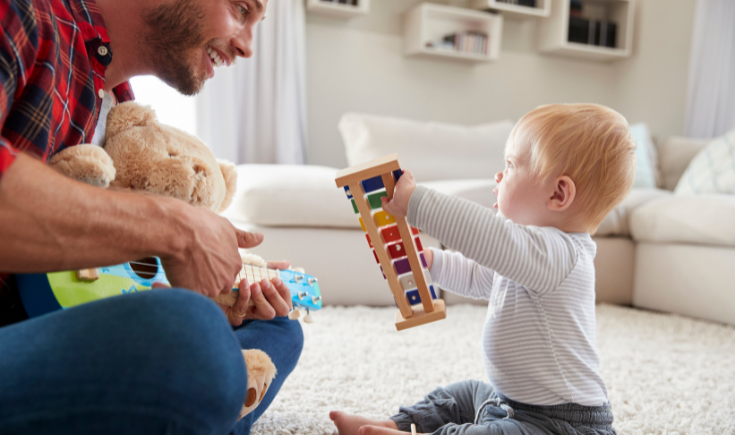

Communication is a fundamental aspect of human interaction, allowing us to connect, express our thoughts, and understand one another. While adults have mastered the complexities of language, toddlers embark on a remarkable journey of communication, gradually acquiring the skills to express themselves. Here we delve into the fascinating world of toddler communication, showcasing their early attempts to communicate through babbling, pointing, and other adorable gestures.
The art of toddler communication: Cracking the code of babbling and pointing
Why do they babble?
Babbling, the delightful and seemingly nonsensical sounds that emerge from a toddler’s mouth, serves as a crucial stepping stone towards language development. As early as six months old, babies begin experimenting with vocalisations, producing a variety of consonant-vowel combinations.
These babbles are often characterised by repetitive sounds like ‘ba-ba’ or ‘da-da’, which serve as practice for coordinating the muscles involved in speech production.
While babbling may sound like gibberish to the untrained ear, it actually plays a vital role in language acquisition. It allows toddlers to explore the sounds and rhythms of their native language, preparing them for the next stage of communication: meaningful words.
By babbling, infants develop the necessary oral motor skills, learn to control their vocal cords, and experiment with different speech patterns.
Initial attempts at speech
Around the age of 12 months, toddlers begin to associate sounds with objects and people in their environment, leading to the emergence of their first words.
These initial attempts at speech are often characterised by simplicity and repetition, as toddlers learn to imitate the sounds they hear. For example, a child might call a dog ‘dada’ or a ball ‘ba’.
While these early words may not resemble the actual words in their native language, they represent a significant milestone in toddler communication.
Non-verbal communication as connection
In addition to babbling and early words, toddlers also rely on nonverbal communication strategies to express themselves. One such strategy is pointing.
Pointing serves as a powerful tool for toddlers to direct attention, make requests, and share interests. When a child points to an object, they are not only indicating their desire for that particular item but also demonstrating an understanding of symbolic representation. They are essentially saying, ‘Look, there it is!’
Pointing also allows toddlers to engage in joint attention, a crucial aspect of social communication. By directing the attention of others towards an object or event, toddlers can establish shared experiences and foster connection.
They learn that communication involves not just expressing their own needs and desires but also actively engaging with others in a reciprocal manner.
Gestures help when words are limited
Apart from pointing, toddlers use a range of gestures to convey their intentions and desires.
They might shake their heads to indicate ‘no’, wave to greet or say goodbye, or clap their hands to show excitement or appreciation.
These gestures provide toddlers with alternative ways to communicate when words are still limited, helping them bridge the gap between their thoughts and external expression.
The skills of communication are interconnected
It is important to note that while babbling, pointing, and gestures are crucial for toddler communication, they are not isolated skills. Rather, they are interconnected building blocks that pave the way for the acquisition of more complex language skills.
As toddlers continue to develop their vocabulary and sentence structure, babbling gives way to articulate speech, and pointing evolves into more sophisticated forms of reference.
How you can help your toddler communicate
As parents and caregivers, we play a vital role in nurturing and supporting toddler communication. Here are some ideas to help promote these skills:
- Use simple and clear language when speaking to your toddler.
- Encourage your toddler to use gestures, such as pointing or waving, to communicate their needs and wants.
- Maintain eye contact and actively listen when your toddler tries to communicate with you.
- Respond positively and enthusiastically to your toddler’s attempts at communication, even if their words or sentences are not fully formed.
- Read books together and point out objects, colours, and shapes to help expand your toddler’s vocabulary.
- Sing songs and recite rhymes that involve repetitive language patterns to enhance your toddler’s language skills.
- Create a language-rich environment by labelling objects and describing actions during everyday activities.
- Play interactive games, such as ‘Simon says’ or ‘I spy’, to encourage your toddler’s verbal participation.
- Use visual aids, such as picture books or flashcards, to help your toddler associate words with images.
- Limit screen time and prioritise face-to-face interactions to promote language development.
- Consider using baby sign language with them.
- Seek professional advice if you have concerns about your toddler’s communication skills or if you notice any delays or difficulties.
Remember, every child is unique, and some may develop communication skills at a different pace. Providing a supportive and nurturing environment is key to helping your toddler communicate effectively.
By actively participating in your toddler’s communication journey, you create an environment that fosters language growth and strengthens the parent-child bond.























